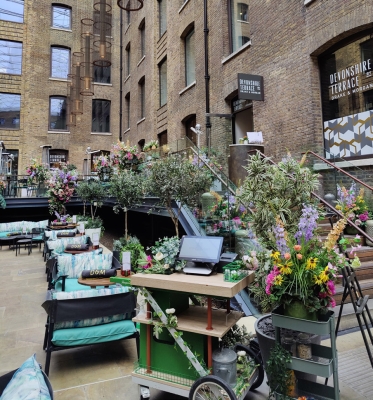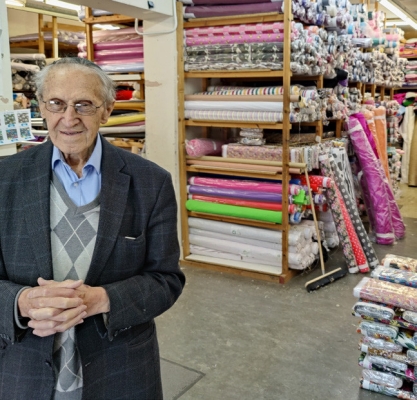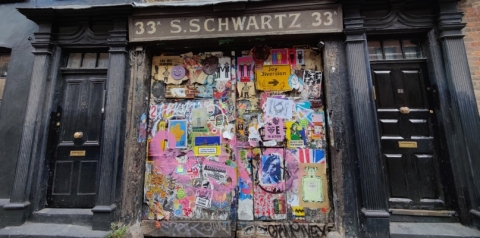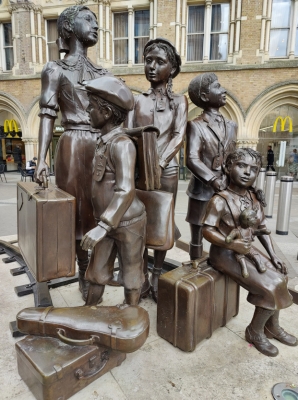Memories of Chicken Soup with Barley
It's taken me since I was 17 and inspired by the outstanding play "Chicken Soup with Barley" by Arnold Wesker, chronicling 20 years in the life of a Jewish family in London's Jewish East End that I studied for English A level, to finally do this urban hike.
Two and a half years since COVID closed down my travel plans had given me plenty of time to read, plan and build a day walking in the footsteps of the hundreds of thousands of Jewish immigrants, who, from the late 19th century until the early 20th century, made this eastern corner of London their home and community kingdom.
My love of geography, social history and hiking all came together as I searched for the remnants of the shuls, schools, businesses, soup kitchens, street markets and vibrant Jewish life – that has all but vanished, bar a Magen David detail on a Bengali school drainpipe or the rusting sign for Suskin Trimming Merchants, one of last vestiges of the once famous shmatter trade.
It was in 1986 that I was last in Bevis Marks Shul for a family wedding, so I chose to start nearby at Old Jewry in Aldgate. Across the road, between the office skyscrapers of today are the plaques to the Great Synagogue at Duke's Place and the First Synagogue after the Resettlement 1657-1701 on Creechurch Lane. Bevis Marks itself, completed in 1701 and the oldest operating shul in UK, was sadly out of bounds, with high building site fences all but hiding it from view, as the area goes through a massive renovation.
A two-minute walk brought me to Cutler Street and the sensational gentrification that I had yet to witness at Cutlers Gardens and Devonshire Square. The high warehouse walls of the East India Company that stored coffee, spices, silk and textiles are still visible.
The area's street markets were dominated by Jewish traders from the early 18th century, as was the textile and local diamond business – and in 1859 the Jewish Board of Guardians, renamed the Jewish Welfare Board, re-renamed Jewish Care – was established at No 13. The area has been transformed into commercial office space, bars, restaurants and a lively, round-the-clock events and entertainment campus. If you haven't been lately – go! - for a wander or an event. I was enchanted to rediscover this eclectic urban oasis.
As you exit, you're on Middlesex Street – home to the famous Petticoat Lane Sunday market. I had to use my imagination on a Thursday morning, to relive childhood memories of trips to see the predominantly Jewish traders entertain the crowd at Petticoat Lane – but there are still many reminders of its Jewish past and present to see.
Outside the Astronomer Pub on Middlesex Street, I found another plaque for the Jewish Board of Guardians, that moved here for its second home from Devonshire Square.
On Widegate Street I stopped at No 31 with many groups to look above a burger bar to admire and photograph the images of bakers at work. In 1710 this had been Levy Bros Matza Bakers. The number of multi-cultural school groups touring and learning about the Jewish East End that morning was quite staggering. None were Jewish, nor were the guides, yet there was a real thirst for social history and understanding past lives of immigrant communities.
Bypassing Sandys Row Shul, and more school groups, to return later for Mincha – I turned down Artillery Passage. This 17th century alleyway still has the feel of a scene from "Oliver" and is crammed with restaurants, cafes and bespoke shops. I smiled to myself that with all the Jewish food outlets long gone from here and the Jewish Soup Kitchen building in the next street, Ottolenghi, the renowned Israeli celebrity chef, restaurateur, and food writer, has his largest restaurant, cocktail bar, and deli tucked down this narrow Georgian passageway!
And as I turned into Brune Street and stood in front of the Soup Kitchen for the Jewish Poor, with the facia displaying 1902 and the Hebrew year 5662, I thought again about Ottolenghi and the queues of indigent Jews, with bowl and spoon in hand, streaming through the Way In on the right and the Way Out on the left, for their daily dose of steaming kosher broth. The building has kept its historical façade, yet today has been converted into the trendy (!) "The Soup Kitchen" flats. Although I searched, the Bengali social housing (council housing in our day) opposite, has totally obliterated any record of the original site of the Jew's Free School.
Wentworth Street at the end of Brune Street was once the Jewish East End "food court" with 15 kosher butchers, delis and bakeries galore and names such as Mossy Marks Deli, Mendel the salmon cutter, Ostwinds, Bonn's, Goides and of course Bloom's sausage factory, making London Jews salivate at the sheer memories!
Popping through Toynbee Hall, opened by Samuel and Henrietta Barnett in 1884, that provided essential community services to the Jewish population, I arrived at the impressive red brick arch remains of the first tenement block funded by Lord Nathaniel Rothschild in 1886 for the predominately Jewish population. The original six-storey blocks have long gone, to be replaced by tiny ground floor flats – still serving the same purpose, though for different immigrant communities.
Wentworth Street leads onto the famous Brick Lane. A huge arch in the colours of the Bangladeshi flag and Bengali street art announce your welcome. Close your eyes and think how by 1930 this extremely long road was once entirely Jewish, with every aspect of the shmatter trade – from gown and corset makers, hosiers, boot and shoe shops, milliners, tailors, trimming merchants, mantle makers and more.
At No 54 I visited Epra Fabrics, the last and only remaining Jewish fabric and textile business. Mr. Epstein (grandfather) his son and grandson – who travel in daily from Hendon – were happy to chat and regale me with stories of Jewish East End past. In the present, they clearly work well with their Bengali neighbors and colleagues and it was heartwarming to see them, kippa clad, doing business with their colorfully dressed multi-ethnic customers.
Aptly named Fashion Street, it gave me my pilgrimage to Arnold Wesker's childhood home at No 43, although the boarded up Ali's Super Store and the graffiti there now were not quite what I was expecting! Israel Zangwill, another famous Anglo-Jewish writer, called this street home too.
Back on Brick Lane, the teacher in the Bengali school was intrigued that I wanted to climb up and photograph the Magen David design on their school drainpipe and there was even Hebrew on the modern sign for Taylor's Yard business space – clearly a recent addition. The signs for CH. N. Katz at No 92 and S. Schwartz at 33A Fournier Street tell of Jewish shops of yesteryear, but they are a mere couple that survive from a world lost.
None more so than Brick Lane Mosque that started life as a Huguenot then Methodist chapel. In 1898 the site was built to house the Spitalfields Great Shul – or better known as Machzeikei Hadath VeShomrei Shabbat congregation. A 500+ boys Talmud Torah was adjacent in its heyday. No evidence to its Jewish history now remains.
And then, of course, there's the famous 24/7 Bagel Bake (unfortunately not kosher, but previously Jewish owned) that has queues down the street, day or night. There were times we used to go there on a Saturday night after Bnei Akiva to take away just plain bagels, with varying opinions as to the "kashrut" – but memories, memories…
With Mincha time approaching, I turned into Princelet Street. The manhole cover with a violin at No 6 commemorates the first purpose-built Yiddish Theatre in London in 1886 and at No 19 is the Museum of Immigration with its own tiny, private Shteibel that was built for the family over the garden in 1869 – complete with ladies gallery.
On to Sandys Row Shul, founded in 1854 by Dutch Ashkenazi Jewish economic migrants seeking a better life, rather than refugees fleeing persecution after them from the Pale of Settlement, is London's oldest still functioning Ashkenazi shul. In its time, there was a shul or shteibel in every street around Sandys Row and the area was filled with Jewish shops, markets, workshops and overcrowded housing.
Sandys Row continued to function through both World Wars and has remained independent. Interestingly enough, in the 1990s it was faced with closure, yet today membership is slowly increasing with a new Jewish generation moving back to Spitalfields alongside descendants of those long affiliated to the shul.
I arrived early, to find another girls school concluding a visit and so was able to see and photograph the open Aron Hakodesh and chat with the convivial shamas/administrator, who travels in from Pinner daily and every second Shabbat, when prayers are held. Most travel in for Shabbat services, he told me, and the rabbi has to accept that is the reality.
At 13:30 some 30-40 businessmen arrived from neighboring city offices for Mincha. Most on foot, some by bike, and most were young and religious. To my surprise, none were saying Kaddish, so this daily minyan really is comprised of the regular devout. On some days they told me, the minyan can number 80-100! A most beautiful gem of a shul - the last bastion of a Jewish community that is now all but a memory.
My last surprise of the day was a short walk to see the refurbishment at Old Spitalfields Market. Established in 1682, it served for centuries as London's wholesale fruit and vegetable market. It traded here until 1991 when it relocated to Temple Mills.
Now, it is a combination of commercial space, retailers, restaurants, market stalls and street food under one Victorian market roof with special events daily. Highly recommended (and lucky!) to go on a Thursday for a terrific antiques market.
There was just one last venue that had been on my to-do list for years in London, and I was five minutes walk away from Liverpool Street Station. Kindertransport – The Arrival is an outdoor bronze memorial sculpture by Frank Meisler that was commissioned to honor the approximately 10,000 children of the Kindertransport who arrived in Britain at Liverpool Street Station along with the people of Britain for taking them in.
Although I had seen numerous pictures of the sculpture and spoken with many who had visited, I was immensely moved to see it that day. My aunt Adela Koor had arrived aged 13 in 1939 on the Kindertransport and when I saw Breslau as one of the cities immortalized on the sculpture, it saddened me even more. Another, smaller memorial of a Jewish boy and girl arriving at Liverpool Street can also be found on the station concourse – but the main sculpture set on train tracks and located outside the station entrance in Hope Square is indeed impressive and moving.
If you've stayed with me this far – thanks! There's much more I visited and people I spoke with and doors I pushed open to awaken memories, ghosts or tales of the past of a Jewish community life that London has never seen since. With future generations now spread far and wide across Jewish London, Britain and even Israel, the interest in our historical, geographical and social and cultural past still holds a special interest in our hearts.














Comments